Victoria Sadler's Blog, page 16
August 25, 2014
Theatre Review: My Night With Reg, Donmar Warehouse
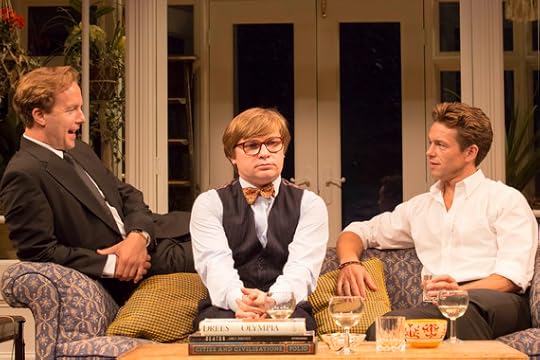
My Night with Reg is a funny, bittersweet play about a group of men and the complex web of friendships and relationships that connects them.
That this story is about gay men in the 1980s and that not all of them make it through to the end alive might give the impression that this is a heavy, depressing play. Not at all. In fact, this play is incredibly funny, with moments of real tenderness. I wasn't bored or depressed for a second.
Guy (Jonathan Broadbent) is a sensitive, romantic soul who's preparing for a house-warming. Yet little does he realise that this one, seemingly innocuous event, will start to unravel the bonds between his friends.
Guy's nursing an unrequited love for the charismatic and handsome John (Julian Ovenden). But John is oblivious to this, instead consumed with his secret relationship with the titular Reg, who just happens to be the partner of his on-off friend of many years, the passionate and extroverted Daniel (Geoffrey Streatfeild).
And complicating the situation even more is the unhappy couple of Benny (Richard Cant) and Bernie (Matt Bardock) who are trying desperately to mask the issues in their rapidly deteriorating relationship.
And thrown into the mix is the young, wide-eyed Eric (Lewis Reeves) whose youth and vitality is a sobering reminder to the middle-aged men of the inevitable passing of time.
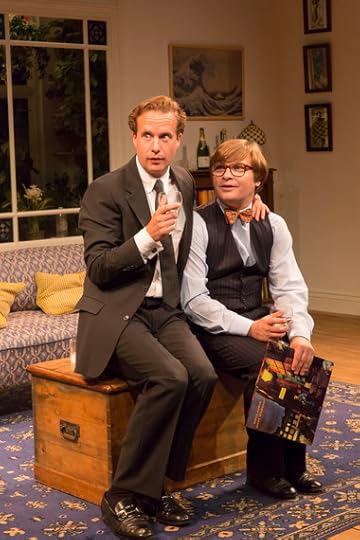
The acting in this play is superb. It seems unfair to pick out any of the six actors in particular as each brings real depth to their parts which, on paper, might seem clichéd. Each is so adept at bringing out the sub-text in the writing, which is so crucial in a play where everyone seems to be holding their cards close to their chest.
The direction from Robert Hastie is excellent. The production is paced perfectly, exploiting the sharp dialogue and witty one-liners in the writing, as well as allowing moments of revelation and tragedy to make their impact.
The time jumps are also cleverly disguised with us, the audience, often playing catch-up when we realise new scenes are set after a passing of time and our brains rush to fill in the gaps, to work out what's happened in-between.
This play was written by Kevin Elyot, who sadly died in June this year, just before this production opened at the Donmar - the first major revival of the play since its premier at the Royal Court in 1994.
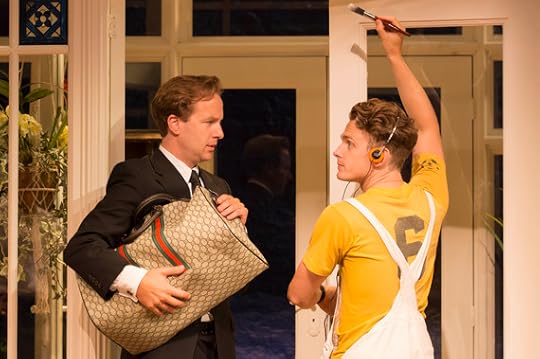
When this play first appeared, many categorised it as a 'gay play' but this is patronising as what I love about this play is how universal its themes are. Yes, this is a play with gay men, but it isn't necessarily a play about gay men. Its themes of love and lies are common to all of us.
That My Night With Reg is set in the 1980s is not hidden. Indeed the play bursts into life to the sound of The Police's Every Breath You Take. And given the prevailing issue of that time, it's no surprise that AIDS looms like a spectre over the lives of these six men.
Prior to seeing this play, I had been anxious that the impact of AIDS might overwhelm the play both dating it and reinforcing an uncomfortable stereotype. Thankfully I was wrong. Though not all the men survive to the conclusion of the play, and it's clear that AIDS is the cause, the disease isn't front and centre.
Instead the play is a beautiful investigation of the impact, good and bad, of an absence of truth and honesty in relationships and as a result, this play remains relevant as well as wonderful.
Donmar Warehouse, London to September 27, 2014
Image credits:
1. Geoffrey Streatfeild (Daniel), Jonathan Broadbent (Guy) and Julian Ovenden (John) in My Night With Reg. Photo by Johan Persson.
2. Geoffrey Streatfeild (Daniel) and Jonathan Broadbent (Guy) in My Night With Reg. Photo by Johan Persson.
3. Geoffrey Streatfeild (Daniel) and Lewis Reeves (Eric) in My Night With Reg. Photo by Johan Persson.
Published on August 25, 2014 06:21
August 21, 2014
New Suffragettes Display at the National Portrait Gallery
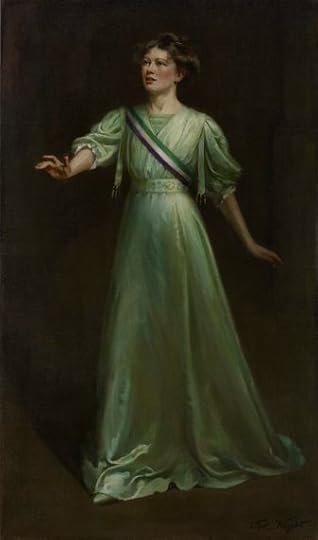
A portrait of Christabel Pankhurst has gone on public display for the first time in 80 years at the National Portrait Gallery.
Alongside the portrait is a display of photographs and archive material of suffragettes, their protests and the headlines they created marking 100 years since the campaigners staged their final and most violent protests, including an attack on National Portrait Gallery paintings, just before the outbreak of the First World War.
Christabel Pankhurst, Emmeline's eldest and most favoured daughter, was central to the Women's Social and Political Union (WSPU), the official name of the suffragettes (the term 'suffragettes' was actually a derogatory term coined by the Daily Mail which Emmeline took up as a badge of honour).
Christabel was instrumental in planning not just the protests but the social and cultural programme for votes for women, including editing the journal The Suffragette.
In the portrait by Ethel Wright, Christabel is in a flowing green dress and wearing a sash comprised of the three colours adopted as a uniform by the WSPU - purple for dignity, white for purity and green for hope.
The portrait was first displayed at the Women's Exhibition which was staged in London, in 1909. Since then it has only been seen at two small exhibitions in the early 1930s, organised by suffrage societies. The portrait was purchased by prominent suffragette Una Dugdale Duval in 1909, and has remained with the family until this bequest to the National Portrait Gallery.
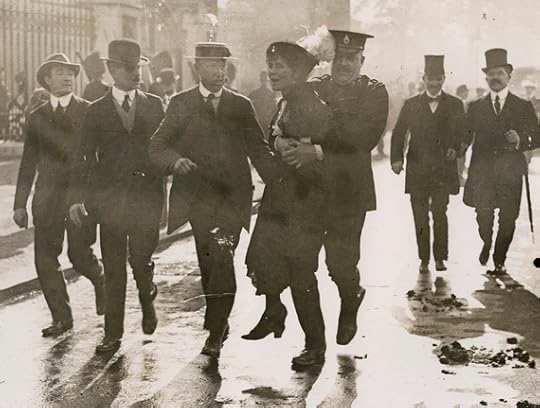
The display supporting this painting is Suffragettes: Deeds Not Words, which explores the events that took place during the final months of the campaign for female suffrage before the outbreak of the First World War.
In these years suffragette action had escalated to civil disobedience and serious vandalism, including arson and bombing, to get their voices heard.
Included in the display are a number of iconic images from the protests, including the funeral cortege for Emily Davison, the suffragette who died in a protest at Epsom Derby. Her funeral was an extraordinary occasion. Thousands of suffragettes accompanied the coffin, most of whom in the WSPU uniform of white, purple and green.
There is also the famous image of an emaciated Emmeline Pankhurst, weak from repeated hunger strikes in Holloway prison, being lifted up and removed from a protest outside Buckingham Palace.
Additionally there are some surveillance photos of some of the suffragettes. As the suffragette protests increased in violence and disruption, the police took undercover photos of the leading ladies in the protests and distributed these to public places such as galleries and shops.
I had seen many of these images before in a more significant display of surveillance of the suffragettes at the Museum of London. However what this display brings is its unique focus on how this fed into art galleries in particular.
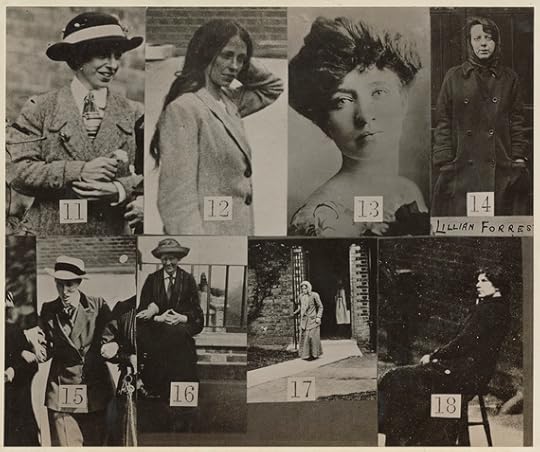
In 1913, Mary Richardson famously took a meat clever to Velazquez's Rokeby Venus in the National Gallery. In this display, the National Portrait Gallery shares confidential communication they received from the police at the time, warning them of possible similar attacks that could happen to them.
In fact these warnings became reality when Anne Hunt entered the National Portrait Gallery with a butcher's cleaver and slashed the portrait of gallery founder Thomas Carlyle, in protest at Emmeline Pankhurst being rearrested.
These documents are fascinating, the highlight of the display. The suffragettes were very much seen, by the police, as the terrorists of their day, in a way that seems perverse and bizarre to us now. It's also a reminder to women on just how violent the fight was - and how resistant the Establishment was - to obtain the vote.
There's also the extraordinary written confirmation that women are not allowed to enter galleries unless chaperoned by a man who could vouch for their behaviour.
Given that this painting and display have been promoted together, it's a little strange that the two are not shown together. Instead the painting of Christabel is opposite a painting of her mother in Room 30, whilst the display of suffragette photos and headlines is in a glass cabinet in Room 31.
Nevertheless, so long as you don't forget one when visiting the other, these present a great opportunity to really see the impact that the suffragettes had on society.
National Portrait Gallery, London to May 10, 2015
Admission Free
Image credits:
1. Dame Christabel Pankhurst by Ethel Wright, exhibited 1909 © National Portrait Gallery, London
2. Emmeline Pankhurst's arrest at Buckingham Palace by an unknown photographer, 21 May 1914 © National Portrait Gallery, London
3. Surveillance Photographs of Militant Suffragettes by Criminal Record Office, 1914 ©National Portrait Gallery, London
Published on August 21, 2014 01:54
August 16, 2014
Art and Design of Protest Movements in Disobedient Objects, Victoria & Albert Museum
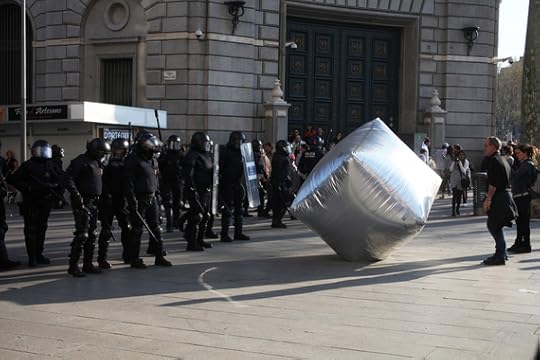
Disobedient Objects has to be the most exciting, dynamic and emotive exhibition I've seen at the V&A. The purpose of this display is to examine the incorporation and evolution of art and design in protest movements across the world and it's very much the first exhibition to attempt this.
The coverage is superb with exhibits on show coming from as far afield as Asia, Australia and South America as well as the US and Europe. There are also pieces from as far back as the suffragettes as well as current protest movements, such as those in Russia and Syria.
It was a real delight to see so much innovation and humour in some of the exhibits on display. The most popular image used to promote this exhibition is of an inflatable cobblestone that was used to throw at police in the 2012 May Day protests in Berlin and Barcelona, which is such an innovative way to reinterpret protesting against police lines.
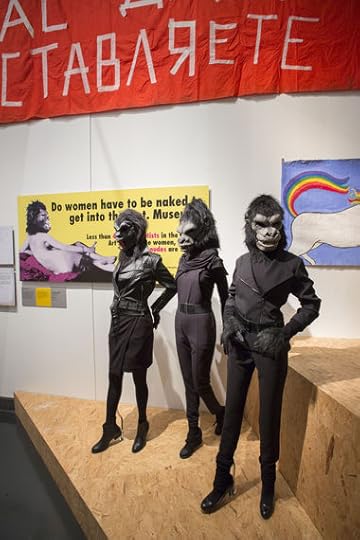
Work from The Guerrilla Girls is also on show, including their gorilla masks along with their famous poster protesting the lack of representation of female artists in the Metropolitan Museum in New York.
It was a great idea to also include some of the vicious mail that Guerrilla Girls have received, as an example of the resistance these protests can provoke. A letter from an Italian art critic, referring to the women as "bitch feminists" shows the level of misogyny that feminists face. "The only thing you feminists teach is to women to be hoars (sic) in love" the letter goes on.
The V&A has also borrowed many distinctive placards from recent protests such as those against tuition fees in the UK and the Occupy movements in London and New York. One that caught the eye was Coral Stoakes' "I Wish My Boyfriend Was As Dirty As Your Policies." It's quick-witted but bitingly satirical slogans such as this that catch the eye of the media, and therefore boost the profile of the protests.
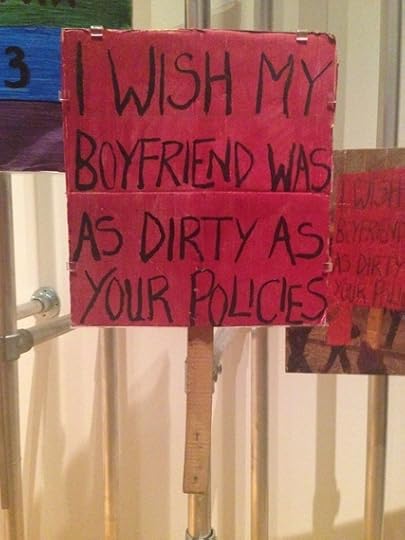
I also particularly loved the Book Blocs where Italian protestors in 2011 who were protesting against the drastic budget cuts brought on by the currency collapse, created cardboard and plexiglass shields decorated with book covers.
So brilliant was this design, that protestors defended themselves from police brutality with the pen rather than the sword, that these were developed and used by other protests such as Manchester in 2011 and New York in 2013, with book covers such as To Kill A Mockingbird and Brave New World poignantly used.
The power of these disobedient objects has also been profound.
I was genuinely thrilled to see one of the McLibel pamphlets included from 1986, one that resulted in a huge PR disaster for McDonalds. Also included was an example of a street sign used in Buenos Aires to identify - name and shame - residences of the Generals who were in charge during the years of the Disappeared.
How the art and design of these disobedient objects incorporates local and regional traditions was one of the most fascinating aspects of this display.
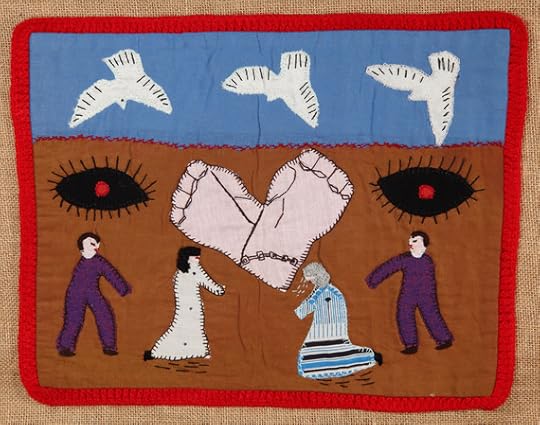
Arpilleras are appliqued textiles made by women in South America that are used to tell stories and those collated here have been used to record massacres and injustices, whether it was the Mampujan Massacre of 2010 in Columbia, where in one night a village was burnt to the ground and the women were violently raped by the army for their opposition to the dictatorship, or to record the violence of the Pinochet regime in Chile back in 1980.
I found this a very emotive exhibition, one that drives up a lot of anger and frustration.
Supporting the exhibits is a number of video clips, including footage from protests such as Tiananmen, the Middle East, Seoul and Japan. The level of violent resistance from the state in almost all instances is incredibly depressing.
And the disproportionate use of that violence can be harrowing to watch. Watching again the tanks of the Chinese Army toppling over the 30ft Goddess of Democracy in Tiananmen Square was quite distressing, as it was to see the footage from Palestine of kids throwing stones with their slingshots, only for their pebbles to be met with gunfire.
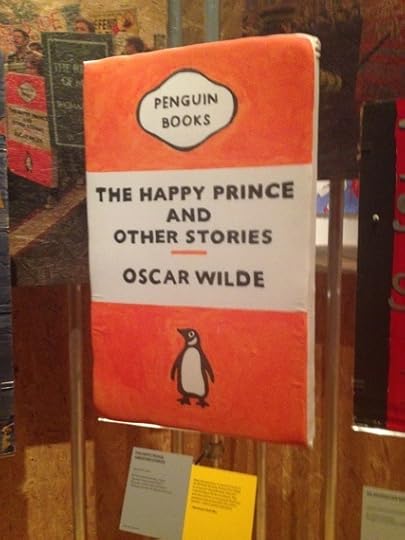
The V&A has managed to obtain one of these slingshots, a makeshift item created from the tongue of a child's trainer, and alongside this VT this really had an impact.
Included in the video clips is commentary and observation from those that have been active in protest movements, or who have studied them.
It's eye-opening to listen to how these movements do bring in the egalitarian principles and community consciousness they want to see in the world, but how they also struggle with gender and class structures within their own ranks.
But it was easy to agree with these commentators that change has only come about from direct action, from challenges to property and power, rather than negotiation and dialogue.
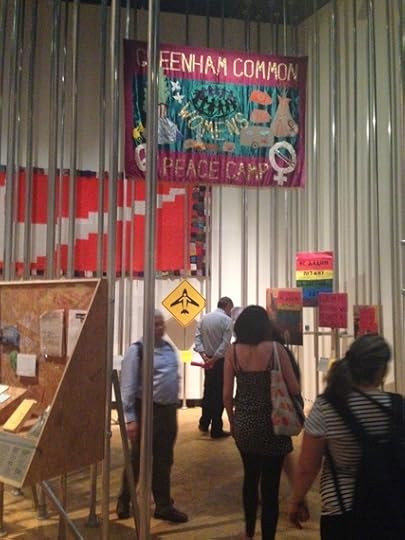
With that in mind, the only thing that bothered me in this exhibition was the representation of the Women's Social and Political Union (WSPU), Emmeline Pankhurst's suffragettes.
As journalist Laurie Penny observes in one of the video clips, the view of many of the suffragettes now is one of quite twee women in their long skirts and pretty bonnets organising fetes and drinking tea.
But these women were incredibly violent, the terrorists of their era. Pankhurst's methods were innovative and ground-breaking, creating the template for so many civil rights movements to follow. The WSPU was the first to use art and design on a mass scale to create an identity, a brand.
How disappointing then that the WSPU was represented by a bespoke teacup and saucer, somewhat reinforcing that passive representation. What opportunity there was to put on show a meat cleaver or one of the hammers that were used in the window-breaking, which showed that Pankhurst had realised the impact of damage to property.
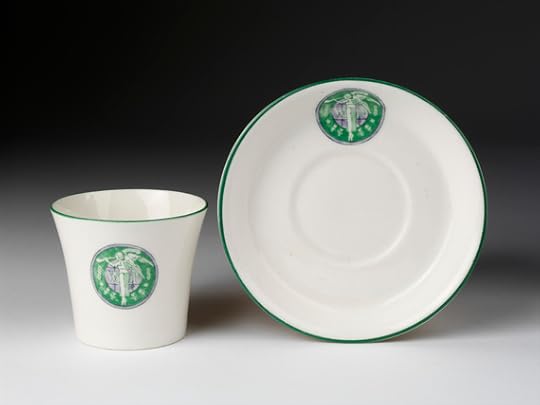
Or perhaps the V&A could have included one of the distinctive sashes or Votes for Women journals, which showed the WSPU's entrepreneurial approach to brand identity and use of the media.
However, this aside, Disobedient Objects is a fascinating thought-provoking exhibition that is well-worth a visit, especially considering this exhibition is free. Highly recommended.
Victoria and Albert Museum, London to February 1, 2015
Admission Free
Image credits:
1. Inflatable cobblestone, action of Eclectic Electric Collective in co-operation with Enmedio collective during the General Strike in Barcelona, 2012 © Oriana Eliçabe/Enmedio.info
2. Installation Image, The Guerrilla Girls, Disobedient Objects © Victoria and Albert Museum, London
3. Installation image, Coral Stoakes Placard (c) Victoria Sadler
4. Chilean Arpilleras wall hanging: Dónde están nuestros hijos, Chile Roberta Bacic's collection Photo © Martin Melaugh
5. Installation image, Book bloc, Disobedient Objects © Victoria Sadler
6. Installation image, Disobedient Objects (c) Victoria Sadler
7. Bone china with transfers printed in green, bearing the emblem of the Women's Social and Political Union (WSPU)Photo © Victoria and Albert Museum, London
Published on August 16, 2014 09:37
August 11, 2014
Fancy Winning One of Benedict Cumberbatch's Suits? You Could Be in Luck...
Anno's Africa is about to kick off one of the most exciting celebrity auctions ever with items donated from stars such as Benedict Cumberbatch, Lana Del Rey, David Tennant, Daniel Craig, Elton John, Tom Hanks, Judi Dench and Ruby Wax.
And the items are not run-of-the-mill signed photos or DVDs. Oh no. Instead stars have lined up to hand over items you'd just never get your hands on any other way. Just take a look at the list below at some of the items donated:
• BENEDICT CUMBERBATCH has signed one of his trademark Spencer Hart suits (though, sadly Cumberbitches, I have to add he doesn't actually come with the suit),
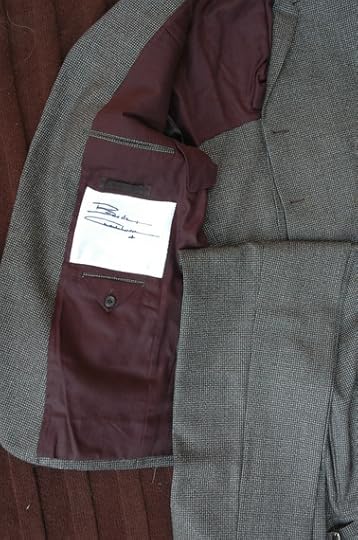

• DANIEL CRAIG has signed and donated one of his Bond shirts from Skyfall (though sadly for me, Mr Craig will not actually come with the shirt *sigh*),
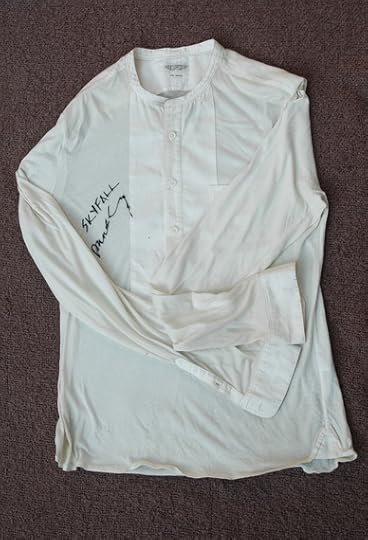
• LANA DEL REY has signed this really quite stunning vintage dress from her recent American Tour,
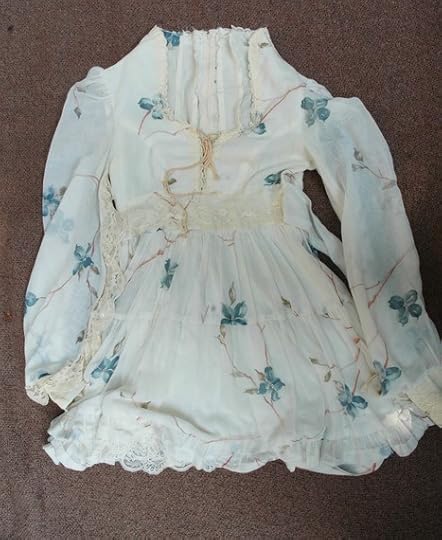
• SIR ELTON JOHN has signed a pair of his Gucci trainers and handed them over, along with this very cool pair of signed Versace sunglasses,

• DAME JUDI DENCH has donated her jacket from The World is Not Enough,
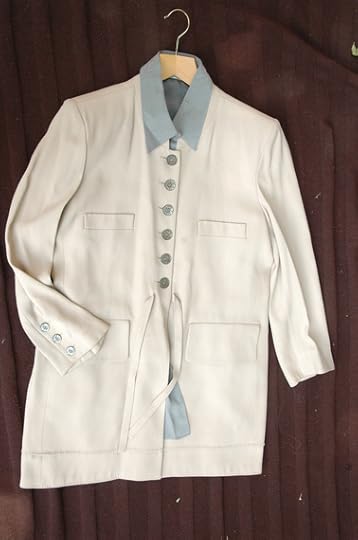
• DAVID TENNANT has signed his script from the wonderful hit ITV drama Broadchurch,
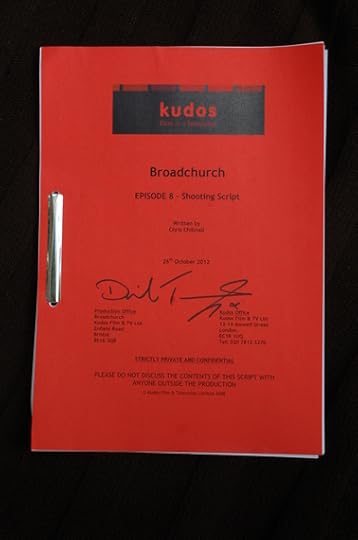
• Top film production company WORKING TITLE has offered a walk-on part in their next film to a winning bidder,

• MILLA JOVOVICH has signed her own label red/white striped chiffon dress that she wore at Cannes. Isn't it chic? I love it.
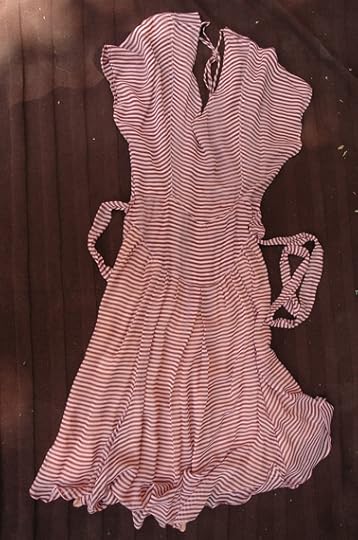
• CHARLOTTE GAINSBOURG has signed her Balenciaga City bag for the auction, and
• Huffington Post's favourite blogger RUBY WAX has donated a pair of her frilly knickers to the auction - signed and framed, naturally!
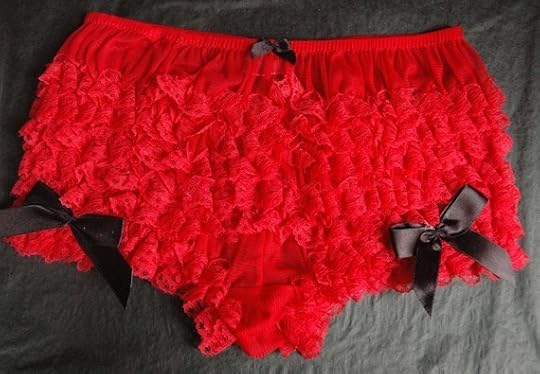
Plus there are dozens of other items that will be on sale including donations from Tom Hanks, Alan Rickman, Matt LeBlanc, Joanna Lumley, Stephen Fry, Simon Amstell, Stephen Frears and Nicholas Hoult amongst many, many others. What a list!
And where can you bid for your chance to own one of these unique pieces? eBay!
Anyone can bid on these items, anyone. You don't have to register, you don't need membership to any club. Just trawl through the dozens and dozens of items that will go on sale on Thursday September 4th and get bidding!
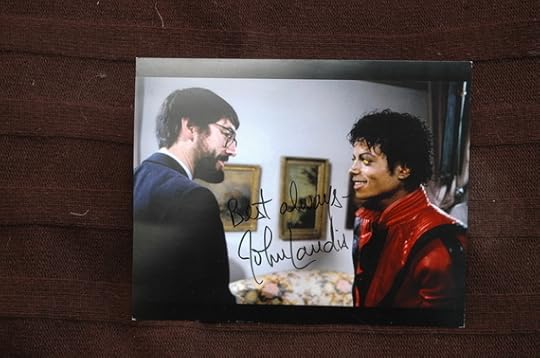
All these items are being auctioned off to raise funds for Anno's Africa, a UK based charity whose focus is on providing creative arts education to orphans and vulnerable children in some of the biggest city slums in Africa.
This charity works with children who are living in the most appalling conditions, often sleeping on the streets or in or in corrugated iron shacks with no amenities. In a world where these children often have to scavenge on rubbish tips to find scraps they can sell just to feed themselves each day, education is a luxury that many of these kids' parents cannot afford.
Anno's Africa therefore works alongside local churches and organisations in providing basic education to these children. Anno's Africa's role is in its provision of a series of workshops in the arts in the curriculum for several weeks each year.
The programme covers five major disciplines: art, drama, music, dance (including ballet) and circus skills. During the workshops the charity also trains local teachers so that the arts projects can become permanent features in these schools.
The auction is designed to raise funds for the charity's 2015 programme so every penny raised will be going to improve the quality of life for children growing up in the most desperate of conditions so all your pennies will be going to a most deserving cause.
The celebrity auction items will all be available for a 10-day auction period so make sure you place your bids before Sunday September 14th if you want to be in with a chance, and good luck!
You can find more information about the celebrity auction and the charity on Anno's Africa website or follow them on Twitter to be kept up to date with all auction news.
All images of auction items © Anno's Africa
And the items are not run-of-the-mill signed photos or DVDs. Oh no. Instead stars have lined up to hand over items you'd just never get your hands on any other way. Just take a look at the list below at some of the items donated:
• BENEDICT CUMBERBATCH has signed one of his trademark Spencer Hart suits (though, sadly Cumberbitches, I have to add he doesn't actually come with the suit),


• DANIEL CRAIG has signed and donated one of his Bond shirts from Skyfall (though sadly for me, Mr Craig will not actually come with the shirt *sigh*),

• LANA DEL REY has signed this really quite stunning vintage dress from her recent American Tour,

• SIR ELTON JOHN has signed a pair of his Gucci trainers and handed them over, along with this very cool pair of signed Versace sunglasses,

• DAME JUDI DENCH has donated her jacket from The World is Not Enough,

• DAVID TENNANT has signed his script from the wonderful hit ITV drama Broadchurch,

• Top film production company WORKING TITLE has offered a walk-on part in their next film to a winning bidder,

• MILLA JOVOVICH has signed her own label red/white striped chiffon dress that she wore at Cannes. Isn't it chic? I love it.

• CHARLOTTE GAINSBOURG has signed her Balenciaga City bag for the auction, and
• Huffington Post's favourite blogger RUBY WAX has donated a pair of her frilly knickers to the auction - signed and framed, naturally!

Plus there are dozens of other items that will be on sale including donations from Tom Hanks, Alan Rickman, Matt LeBlanc, Joanna Lumley, Stephen Fry, Simon Amstell, Stephen Frears and Nicholas Hoult amongst many, many others. What a list!
And where can you bid for your chance to own one of these unique pieces? eBay!
Anyone can bid on these items, anyone. You don't have to register, you don't need membership to any club. Just trawl through the dozens and dozens of items that will go on sale on Thursday September 4th and get bidding!

All these items are being auctioned off to raise funds for Anno's Africa, a UK based charity whose focus is on providing creative arts education to orphans and vulnerable children in some of the biggest city slums in Africa.
This charity works with children who are living in the most appalling conditions, often sleeping on the streets or in or in corrugated iron shacks with no amenities. In a world where these children often have to scavenge on rubbish tips to find scraps they can sell just to feed themselves each day, education is a luxury that many of these kids' parents cannot afford.
Anno's Africa therefore works alongside local churches and organisations in providing basic education to these children. Anno's Africa's role is in its provision of a series of workshops in the arts in the curriculum for several weeks each year.
The programme covers five major disciplines: art, drama, music, dance (including ballet) and circus skills. During the workshops the charity also trains local teachers so that the arts projects can become permanent features in these schools.
The auction is designed to raise funds for the charity's 2015 programme so every penny raised will be going to improve the quality of life for children growing up in the most desperate of conditions so all your pennies will be going to a most deserving cause.
The celebrity auction items will all be available for a 10-day auction period so make sure you place your bids before Sunday September 14th if you want to be in with a chance, and good luck!
You can find more information about the celebrity auction and the charity on Anno's Africa website or follow them on Twitter to be kept up to date with all auction news.
All images of auction items © Anno's Africa
Published on August 11, 2014 11:24
August 9, 2014
Gillian Anderson Stars in A Streetcar Named Desire, Young Vic Theatre
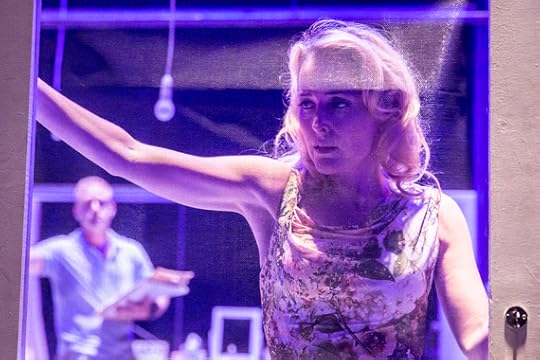
A Streetcar Named Desire is Tennessee Williams' finest play and in this deeply affecting production at the Young Vic, Gillian Anderson gives quite probably her finest performance as Blanche DuBois, the desperate woman whose life falls apart under the overwhelming pressure from reality and the crushing brutality of Stanley Kowalski.
Gillian Anderson's performance as Blanche, the woman who is hiding a lot of secrets and damage behind her charming façade is captivating. Her Blanche is so fragile, so delicate. You sense that she is just teetering on the edge of sanity, that her walls are so frail that they could come down at any moment.
And of course, it is Stanley Kowalski, her sister Stella's thuggish partner, who smashes down those walls, shattering Blanche's reality for good.
Gillian's performance is superb and she is supported by an excellent Vanessa Kirby as Stella, the passionate young woman whose desire for her Stanley is as strong as her willingness to protect her vulnerable older sister.
Ben Foster's Stanley is brutish but, for me, lacked the raw sexuality and the charisma that is crucial in depicting Stanley as the complex man that he is. Foster's presence is intimidating but not as overwhelming, as suffocating, as he could have been.
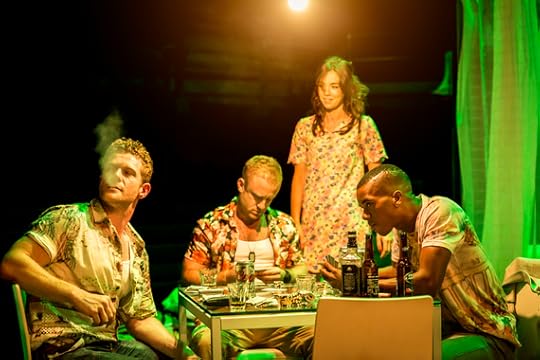
Directing the modern-dress production is Benedict Andrews and his pacing of the piece is superb, giving space to the actors to allow the power play between Blanche and Stanley to play itself out with Stella as their battleground.
Blanche, complete with her designer shades and Vuitton luggage, arrives unannounced at her younger sister's run-down place in New Orleans. Her refined airs and graces are at complete odds with Stanley's thuggish outlook yet these are both defensive, needy people and there's plenty of tension in the first half as these two adversaries circle each other, desperate to keep Stella for themselves.
There's a real spirit to Gillian Anderson's Blanche in this part. You sense she is a real fighter as she urges her sister to see sense over the violence in her relationship with Stanley. But you also feel Stanley biding his time, working out how to outmanoeuvre the interloper in his home and it is in the second half of the play that we see Stanley gain the upper hand as he starts to tear down Blanche's defences, literally and metaphorically.
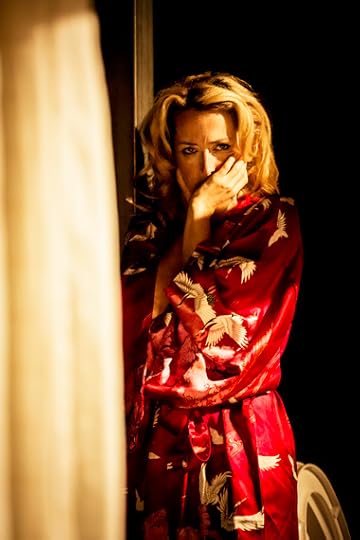
A word also for the set design from Magda Willi. Its simplicity is deceptive, with flimsy curtained partitions and non-existent walls working on so many levels. And the set revolves slowly throughout, which you'd think would be distracting but actually just adds to the unsteady emotion in the play.
But for all that is great about this production, it is Gillian Anderson's central performance that will stay with you long after the curtain falls. She is astounding. Her acting is so intense, so believable that your heart just breaks for Blanche. It's an incredibly affecting, moving performance.
Yet such was the expectation that Gillian Anderson would deliver such a seminal performance that this show was the fastest-selling production in the Young Vic's history. Advance tickets for the run have therefore already all sold out.
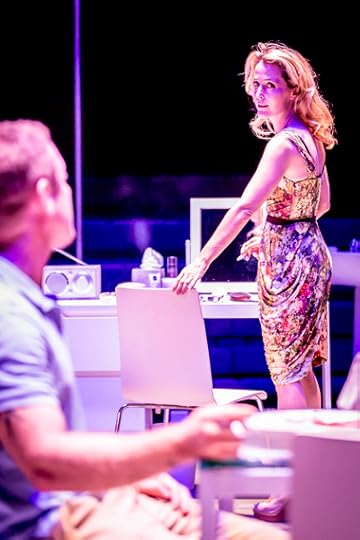
However the Young Vic does release tickets every day as part of its day lottery. Head on down to the Young Vic at 5pm each day and they'll take your name. Names will be drawn at 5.30pm with all tickets £20, with a £10 concession for Under 26s. Returns will also be on sale.
And if this proves impossible, the Young Vic has teamed up with NT Live to broadcast A Streetcar Named Desire live to over 1,000 cinemas around the world on September 16th so do have a look at the
Young Vic Theatre, London to September 19, 2014
Image credits:
1. Ben Foster and Gillian Anderson in A Streetcar Named Desire, Photo by Johan Persson
2. A Streetcar Named Desire at the Young Vic, Photo by Johan Persson
3. Gillian Anderson as Blanche DuBois in A Streetcar Named Desire at the Young Vic, Photo by Johan Persson
4. Ben Foster and Gillian Anderson in A Streetcar Named Desire at the Young Vic, Photo by Johan Persson
Published on August 09, 2014 10:05
August 7, 2014
Review: The Human Factor at Hayward Gallery
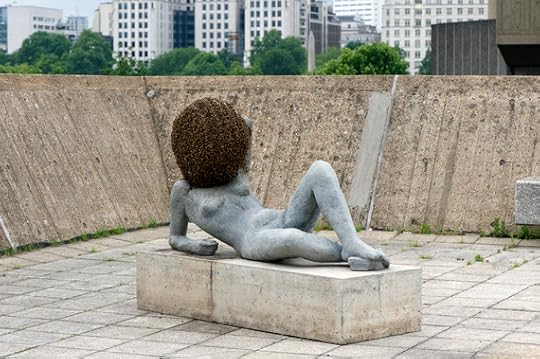
Twenty-five seems to be the magic number for this fascinating and provocative exhibition at the Hayward Gallery that looks at how leading artists have explored and fashioned new ways of using the human form in sculpture.
The works on show are from 25 leading international artists and span the past 25 years. Some of them are funny, some are traumatic. Some of the pieces seem so real, so true to life you could be forgiven for believing you are looking at a living statue.
But together they are a terrific and thought-provoking showcase that uses the figure to reflect such far-ranging concerns as voyeurism, sexuality, violence, mass consumerism and even morality.
For me, the most stunning and most controversial piece of work on show is Paul McCarthy's That Girl, 2012-13 a display of three figures based on the same model.
These figures are incredible. Made from silicone, paint and even real hair, their bodies, their skin is so true to life you are drawn in, disbelieving that these are not real people. You want to reach out and touch the "skin". Faint traces of veins can be made out, as can the wrinkles around the knuckles and even the flush of red in their ears.
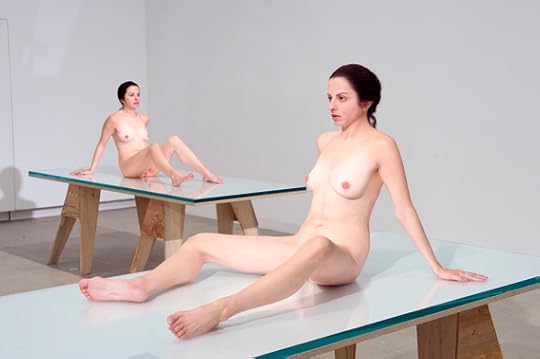
But the pieces are controversial - deliberately - because of what they provoke in the audience.
On entering the room where these figures are placed, the first thing your eyes are drawn to is the labia of the first model you see. For the models are all completely nude and sat with legs spread on bare tables.
It was fascinating watching the visitors come into the room, witnessing their initial reaction. Most were surprised, some were shocked. Almost all looked away, just briefly, embarrassed and a little unsure where to look.
And that is just the kind of reaction the pieces are designed to provoke as these are a commentary on how we respond to the female nude. What is the line between spectatorship and voyeurism? What is prompting us to look away when we see female genitalia so exposed as, in comparison, the number of penises on display elsewhere in this exhibition?
The sexualised female form surrounds us every day, objectified and air-brushed for our entertainment but here, we don't know where to look. Fascinating.
This exhibition has been superbly curated, making great use of the available space. You can definitely see why it has just been short-listed for the Art Fund prize of Museum of the Year.
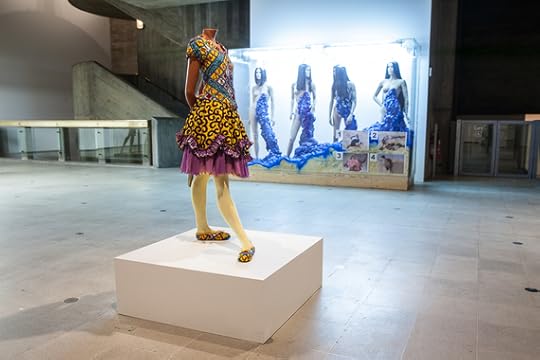
The sculptures are given plenty of room throughout the galleries to allow visitors to move around the pieces, really see each piece without being distracted by cramped, overfull galleries. Some pieces are even displayed outside on the gallery's terraces.
Some of the works on show though are bright and colourful, which act as a great contrast to the more traumatic and sombre pieces on display.
Jeff Koons' Bear and Policeman 1988 looks at the impact of power and mass consumerism in relationships by having a life-sized bobby, usually the symbol of authority, being dwarfed by a giant teddy bear.
I particularly liked Georg Herold's oversized vivid pink form comprised of wooden batons encased in a wet canvas that shrunk over the sculpture, giving it a "skin." With its hips thrust forward and arms aloft, it comes across as both sexually aggressive and vulnerable.
As well as the human form in life, death is a theme addressed by a number of the pieces on show and some of these are quite harrowing.
Paloma Varga Weisz's Lying Man 2014 is a charred wooden male nude lying on the gallery floor. Its body parts are severed, as if the piece has been attacked by a machete. It makes you think as much about the human body not on show here - the person who wielded the weapon - as it does about the figure on the floor.
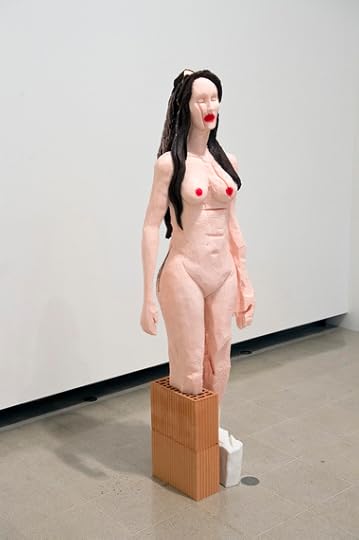
Thomas Hirschhorn's 4 Women, 2008 is even more troubling. Four female mannequins, each gradually drowning further in blue liquid, are shown alongside four images (downloaded from the internet) of mutilated male corpses - a commentary on the abstraction of the destroyed human body.
But for all these violent deaths and dismembered bodies, I found the most thought-provoking piece on this subject to be Urs Fischer's Untitled, a cast wax candle sculpture of a body that is melting away under the heat from the flame. A constantly evolving piece of art, the work is reshaped every moment through the drips of wax and the disintegrating form. As in life, nothing remains the same even in death.
Art though wouldn't be art without it being divisive and not all of the pieces on show appealed to me.
Rachel Harrison's satirical pieces Jack Lemmon, 2011, a figure of Dick Cheney fishing for lemons, and Schmatte with President, 2006 a pastiche on Mount Rushmore with a mask of Abraham Lincoln affixed to a polystyrene block, passed me by.
Katherina Fritsch also had a few pieces on show such as Riese Und 4. Postkarte, 2008 and Koch Und 6. Foto, 2006/8 where figures, such as cooks and caveman-like trolls, were placed in front of giant location images such as a restaurant or a forest. I didn't really take much from them either.
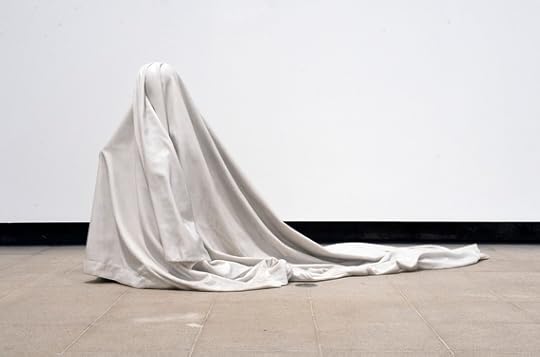
But in amongst all this angst and analysis, there are moments of beauty. So let's end this on one of those moments.
Ryan Gander's Tell my Mother Not to Worry (ii), 2012 is a life-sized representation of his 4-year old daughter playing around with bedsheets, pretending to be a ghost. There's something so touching, so playful about this. It reminds you that the body can be used for as a medium for joy and happiness too. Wonderful.
Hayward Gallery, Southbank Centre to September 7, 2014
Image credits:
1. Pierre Huyghe Liegender Frauenakt (Untilled 2011-2012), 2012 Installation view, The Human Factor, Hayward Gallery 2014, Photo Linda Nylind
2. Paul McCarthy, That Girl (T.G. Awake), 2012-2013 (detail), Installation view, The Human Factor, Hayward Gallery 2014, Photo Linday Nylind © Paul McCarthy
3. Installation view, The Human Factor, Hayward Gallery 2014, Photo Victor Frankowski 51 including Yinka Shonibare's Girl Ballerina and Thomas Hirschhorn's 4 Women, 2008
4. Urs Fischer, Untitled, 2001. Installation view, The Human Factor, Hayward Gallery 2014, -® The Artist, Photo Linda Nylind
5. Ryan Gander Tell my mother not to worry (ii), 2012 Installation view, The Human Factor, Hayward Gallery 2014 © the artist Photo Linday Nylind
Published on August 07, 2014 01:53
August 3, 2014
Moving and Insightful Virginia Woolf Exhibition, National Portrait Gallery
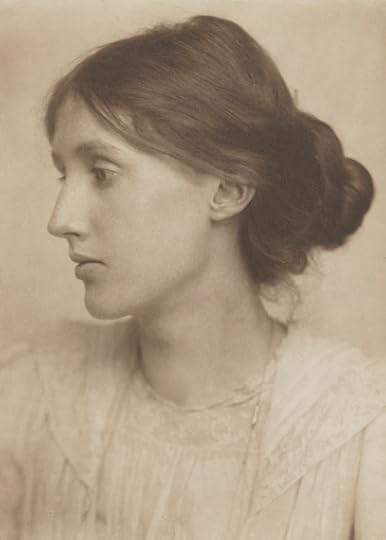
Virginia Woolf: Art, Life and Vision at the National Portrait Gallery is the first exhibition to explore the life and achievements of Virginia Woolf through portraiture.
There are over 140 items on display including paintings, photographs and rare archival material which together, really bring to life both the Bloomsbury Group and Virginia in particular.
The exhibition starts, not with Virginia's birth, but with the destruction of her Tavistock Square house in a German bombing raid in the Second World War.
It's an interesting opening but also a smart one as Virginia was a private woman, having once commentated that "I must be private, secret, as anonymous and submerged as possible in order to write."
But this very public act of destruction of her former house and meeting place for the Bloomsbury Group gives us an opportunity to see inside not just her home, but also understand Virginia's interests.
To know all about Virginia Woolf, of course you have to learn much about the Bloomsbury Group, the influential group of writers, artists, thinkers and philosophers that Virginia and her husband Leonard were key members of.
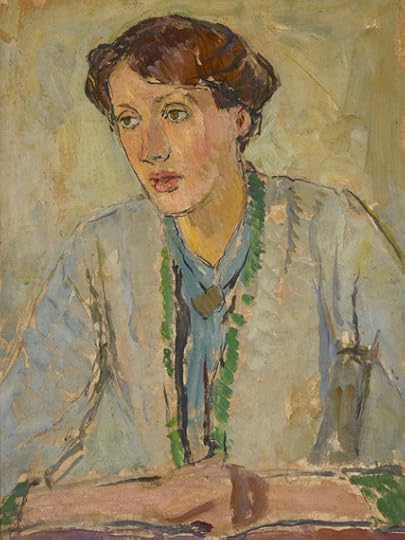
On show are a number of portraits both of Virginia and of key members of the Group such as Roger Fry and Duncan Grant by other members of the Group, including Vanessa Bell, Virginia's sister.
The intellectual stimulation and inspiration that Virginia took from this group is evidenced in the display not just through the impact that their thought had on her writing, but also in the creation of the Hogarth Press, which Virginia and her husband started to publish works that challenged conventional thought.
An early manuscript of James Joyce's Ulysses is on show, which was offered to the Hogarth Press for publication.
Sadly Virginia and her husband had to decline as their production process was intensively manual and the length of Ulysses was prohibitive but Virginia's comments on the book in a note in the exhibition made me laugh and nod knowingly, describing it as "spasms of wonder, of discovery, and then again... long lapses of intense boredom."
The exhibition looks at how all these external influences impacted Virginia's writing. Virginia responded to living in London on many levels and it led to a phase of enormous productivity where she completed Mrs Dalloway, To The Lighthouse, Orlando, A Room of One's Own, The Waves and Flush all in less than a decade.
And certainly the influence of the Bloomsbury Group and their promotion of democracy, anti-imperialism and anti-warmongering can be found in Virginia's writings as well as in her activism.
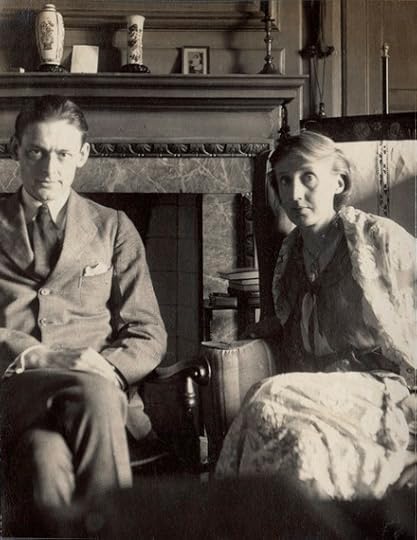
Woolf's political awareness was particularly prominent during the Spanish Civil War. In her book Three Guineas, published in 1938, Woolf asks "What can we do to prevent war?", and she supported fundraising events for those affected by the Spanish Civil War. The exhibition includes one of Picasso's Weeping Woman drawings which he created specifically for a fundraising event at the Royal Albert Hall, at which Virginia and Leonard Woolf sat on the platform.
Supporting the paintings and archive materials are also many photographs of Virginia inside 52 Tavistock Square, two floors of which were set aside solely for the Hogarth Press. These include shots taken by such important photographers as Man Ray, and Beck and McGregor who photographed Woolf for Vogue.
Virginia had this very fragile beauty, which made her incredibly photogenic. Her beauty just radiates from these photographs. But she also had a troubled mind and in none of these pictures is she smiling or uplifted.
For casting a shadow over Virginia's life was her battle with mental illness.
It would be impossible for an exhibition about Virginia Woolf to be complete without addressing this but the National Portrait Gallery have handled this beautifully, not letting it weigh the exhibition down but showing how its reoccurrences affected Virginia's work and her marriage, before it overtook her life completely.
Virginia's nephew - Vanessa Bell's son - died in the Spanish Civil War where he had volunteered as an ambulance driver. The loss of her nephew affected Virginia greatly but it was her sister who suffered more, having a complete nervous breakdown.
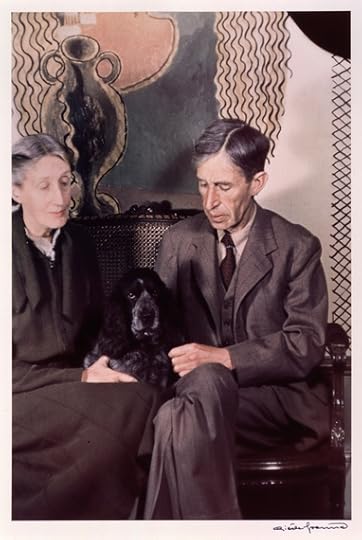
Virginia nursed her sister back to health but her own health soon suffered. The exhibition has on display some hand-written notes that Virginia wrote to her husband and her sister in the days and weeks before she committed suicide in 1941.
These are incredibly affecting to read - both for Virginia's insight into her own illness, aware that the darkness was falling, and because we know how this sadly ended.
"I am certain now that I am going mad again", she writes. "It is just as it was the first time." And in a second letter she adds "I feel certain that I am going mad again... I can't fight it any longer."
It's an incredibly sad way to end this exhibition but probably the most appropriate ending.
I would recommend this exhibition completely for both fans of Virginia Woolf and those who know very little about her as the combination of photos, portraits and diaries really bring to life the woman and the world in which she lived.
National Portrait Gallery, London to October 26, 2014
Image credits:
1. Virginia Woolf by George Charles Beresford © National Portrait Gallery, London
2. Virginia Woolf by Vanessa Bell c.1912. Copyright: Estate of Vanessa Bell, courtesy Henrietta Garnett. Photo credit: © National Trust / Charles Thomas
3. T.S. Eliot and Virginia Woolf by Lady Ottoline Morrell, June 1924. Copyright: National Portrait Gallery, London
4. Virginia and Leonard Woolf by Gisele Freund, 1939. Copyright: Estate Gisèle Freund / IMEC Images
Published on August 03, 2014 09:44
July 30, 2014
Dark, Disturbing and Extraordinary. Review: The Nether, Royal Court Theatre
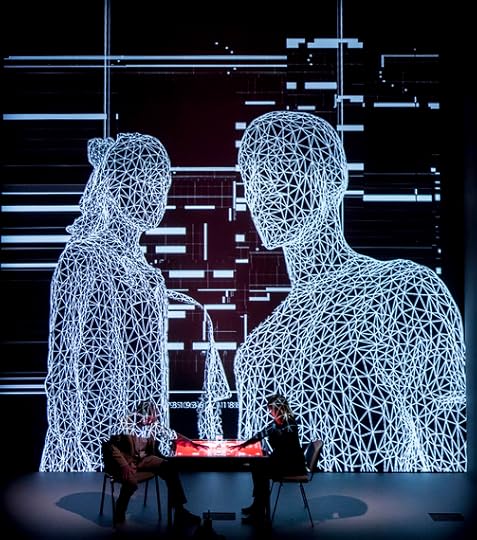
The Nether is a dark, dystopian play that explores the worst of human behaviour in a world where we live almost entirely in a virtual reality. It is disturbing but it is compulsive viewing. You can't look away no matter how much you want to.
The Nether is set in the (probably, and rather worryingly) not too distant future where anyone and everyone can live vicariously through an avatar, where every experience and ever possibility can be explored.
Yet, much like Inception, the lines between reality and virtual existence have become blurred and some, obsessed with their virtual existence, are beginning to "cross over" to subsume themselves in their virtual existence completely.
This premise is powerful because it's believable. There's so much to explore in this set-up yet writer Jennifer Haley has focused specifically and deliberately on the darkest corners of this virtual universe, where adults grab the opportunity to explore their darkest, and criminal, fantasies.
The Hideaway is one of the darkest corners of The Nether, a paedophile's paradise created by a Mr Sims (a superb performance from Stanley Townsend) who provides his guests with the perfect getaway for them to explore every part of these darkest fantasies - the abuse and murder of children.
It may be distasteful, it may sicken us. In reality Mr Sims would be jailed for life. But in The Nether, is this activity safe? If you create an avatar and your avatar is a serial paedophile, is that a crime? And specifically, is a virtual paedophile as real a threat as one in reality?
Morris (Amanda Hale), a detective investigating The Nether, thinks so.
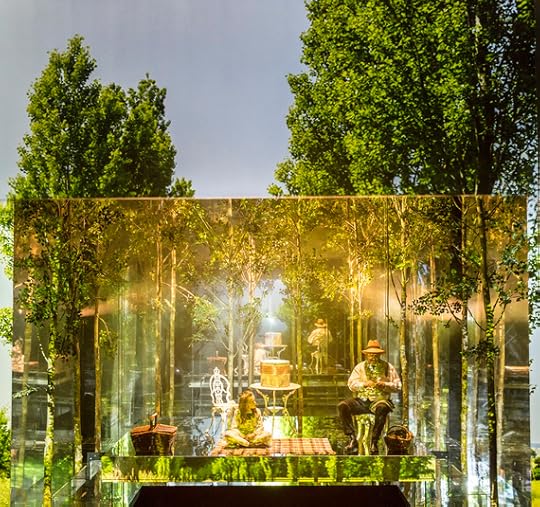
Her opinion is that a crime online is as dangerous as a crime in reality and that there are always consequences, even if the participants kid themselves that this is a safe zone. As a result, she has tracked down the creator of The Hideaway, Mr Sims, and is interrogating him both with the aim to shut down The Hideaway, but also to expose possible similar activity in reality.
The Nether is a co-production between the Royal Court and Headlong. Directed by Headlong's Artistic Director Jeremy Herrin, the play has all the pace, energy and drive that are the hallmarks of his other shows such as Wolf Hall and This House. As a result, the piece grabs you and keeps you involved, hooked throughout.
As the play constantly moves back and forth between the emotional, anxious interrogation of Mr Sims in reality and the sinister idyll of The Hideaway, it would've been easy to lose or confuse the audience. Instead one of the biggest challenges facing this production is one of its biggest successes.
Portraying a virtual existence on stage could - and should - have been a nightmare. There is real discomfort when a production is reliant on video projections, and watching characters tap endlessly on keyboards is dull.
Instead, Jeremy Herrin and Es Devlin have created an extraordinary partitioned set where, the dark, functional interrogation room at the front of the stage is contrasted, as the partition dissolves, with a spectacular representation of The Hideaway.
The Hideaway is flooded with bright sunshine and it's filled with perfectly proportioned poplar saplings. In the centre is a perfectly pristine Edwardian-style existence where the children are innocent and naïve and enjoy nothing more than playing with white rocking horses, and paying with their guests.
The acting from the small cast of five is excellent but special mention must go to Isabella Pappas, the young girl who plays the much-desired 9-year old Iris, the fantasy child in The Hideaway who all the men crave.
As a young girl, protecting her from the darkest parts of this subject matter must have been difficult but her portrayal of this perpetually underage girl happily submitting herself to the whims and fantasies of the guests is extraordinary. Her ability to play both the innocence and the knowing was quite something. She gave one of the most impressive performances that I have seen on stage this year.
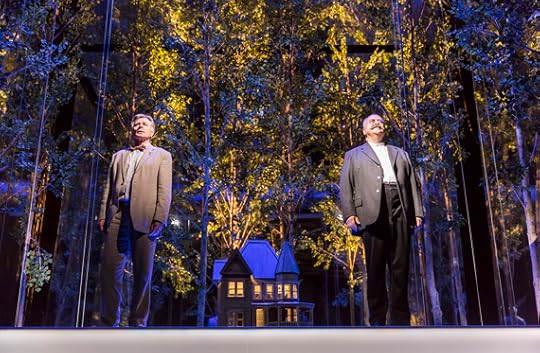
But like Morris, as we see Iris entertain her guests, we are also battling with the question of whether this is ok. Is Iris safe? Is Iris real?
Jennifer Hayley's writing is sharp and well-balanced. At just 90 minutes, this production asks all the right questions yet deliberately leaves us with no easy answers, a pretty impressive achievement given the subject matter.
The Nether is a tremendous production, a cold, hard look at human behaviour. Two days later I still don't know how I feel about the questions posed, or whose side in the argument I am on.
Is virtual reality safe? I am still unsure. But what is it in us that compels us to create such a powerful alternative reality? What are we running from? And more worryingly, what are we running to?
I still believe passionately that the internet can be a force for good, a forum for profound and beneficial social change. But The Nether does not shirk away from the fact that there are corners of the human mind, and therefore of the virtual world, that are very dark indeed. How we deal with this, we still don't know.
Royal Court Theatre, London to August 9, 2014
Image credits:
1. David Beames (Doyle), Amanda Hale (Morris) © Johan Persson
2. Zoe Brough (Iris), Stanley Townsend (Sims) © Johan Persson
3. David Beames (Doyle), Stanley Townsend (Sims) © Johan Persson
Published on July 30, 2014 10:05
July 25, 2014
Stunning Malevich Exhibition at Tate Modern
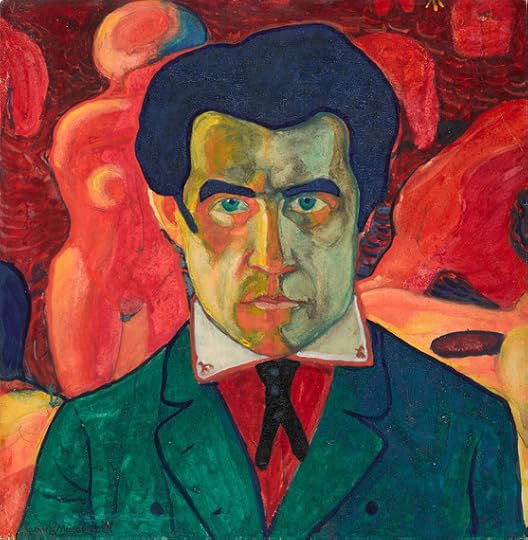
In this first ever retrospective of Kazimir Malevich's work for almost 25 years, the Tate Modern has brought together a stunning collection of his work that offers not just an expansive view of this influential Russian artist's career - but also puts into context how radical and revolutionary Malevich was.
Malevich's Black Square is definitive not just for the artist but also for the evolution of art. Yet Malevich is so famous for his terrifying, distressing Black Square that it's hard to believe that you are greeted with a riot of bright colour as you step into this exhibition - but you are.
In his early years, Malevich was heavily influenced by the European impressionists and post-impressionists, and this was reflected in the beautiful figurative and landscape paintings he completed in his twenties.
The rich colours and sensual forms in Bathers Seen From Behind, 1910 and the bright, idealised Seurat-inspired pointillism in Church, 1905 and Village, 1906 may seem a world away from how we remember Malevich but they are ample proof of his incredible talent when measured alongside the work of his peers.
Born in Kiev in 1879, Malevich travelled to Moscow in 1904 where he studied original paintings by Monet, Cezanne, Picasso and Matisse, and it's clear from these early pieces that he completely absorbed their styles.
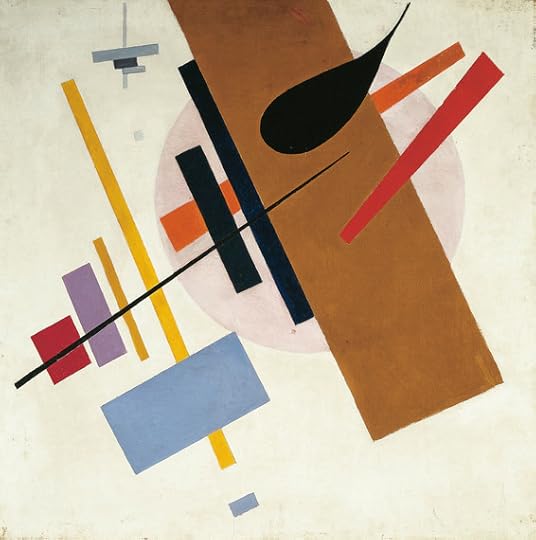
Yet even in these early days, Malevich's desire to find a specifically Russian approach to art could be seen in his interesting take on religious icons in Assumption of a Saint, 1907-8 and Woman in Childbirth, 1908, whose stunning gold images draw heavily from the Russian Orthodox religion.
But at the turn of the twentieth century, these rosy bold images did not reflect life in Russia where riots and uprisings were routine, and were often suppressed by ruthless, brutish violence. The Tate's chronological approach in hanging this exhibition therefore shows not just how Malevich's style developed, but also how it was influenced by the turbulent politics of the time.
As Malevich pursues his desire to develop a uniquely Russian form of modernism, fusing the avant-garde with simplified forms, there's a sharp change in Malevich's style as the romantic pastel palette gives way to bold reds and browns, and lines and images become simpler and stronger, as can be seen in Self Portrait 1908-1910.
Malevich soon turned to cubism, but rather than focusing these fractured perspectives on industrialism and machinery, he chose to reflect traditional Russian scenes such as the rural lives of peasants.
And still Malevich developed his style. His cubist period became a stepping stone as he wrestled with logic and rational order in art, a battle that reflected the revolutionary chaos on Russia's streets.
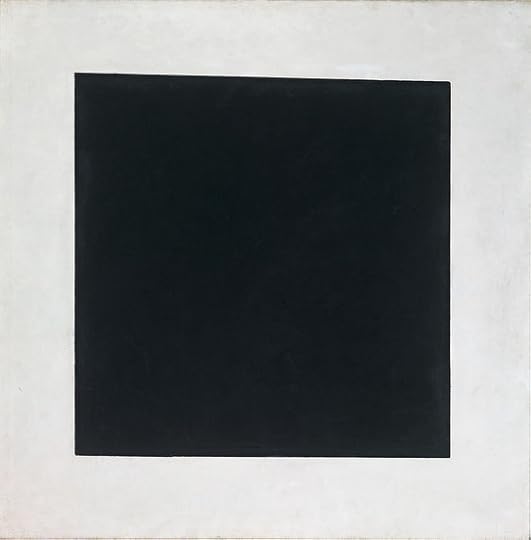
"Logic has always placed a barrier against new subconscious movement" he said, and Malevich's work demonstrate this battle with pictures such as Cow and Violin, 1913, where two objects that do not match are brought together.
Of course this battle culminated in the "zero hour" of modern art - Black Square, 1915.
The original Black Square remains in Russia, it is way too fragile to move. But Malevich painted four versions of this extraordinary piece of work and two of these versions, painted in 1923 and 1929, are on display here.
They really are just extraordinary paintings, phenomenal in their intensity, bleakness and anger. Even Malevich recognised how revolutionary his own painting was, referring to it as the "face of the new art ... the first step of pure creation". Malevich even went so far as to give his new style a name - suprematism.
Figurative art or landscapes had no place in suprematism. As Malevich said, "the artist can be a creator only when the forms in his picture have nothing in common with nature."
Malevich's suprematism vision can be seen in the large number of paintings that fill the next few rooms in this vast ten-room exhibition. Pieces such as Supremus No. 55, 1916 perfectly reflect the style of his work at the time.
However Russia was involved in a disastrous war in these years, which was only to be followed by a year of violent revolution, which was only to be followed by a civil war. Inevitably, given the turmoil, Malevich could only work intermittently during those years. Indeed the dozens of miniscule drawings and detailed preparatory sketches reflect the fact that paper itself was a scarce, precious commodity at this time.
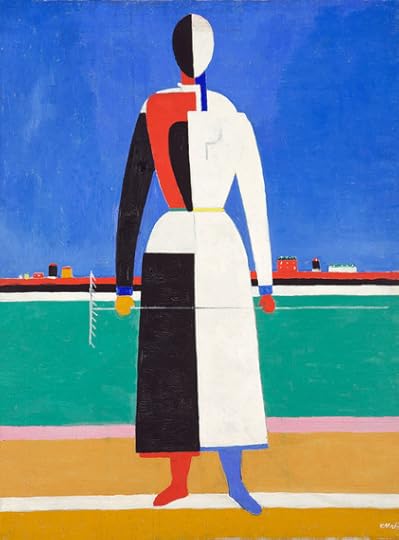
In the late 1920s, as Stalinism brought the valour of the Russian peasant front and centre, there is a return to including figures in Malevich's art - though they are in simplified form. However the bright colour palette also returns, such as in Woman with Rake 1930-32.
However the 1930s were dark years for Malevich. He was arrested in 1930 and held for 2 months, accused of espionage. Soon after, Malevich developed cancer and he died in 1935, aged 56.
But his work had already suffered at the hands of Stalin. Not only had the espionage fears removed him from favour, but his style had been rejected by the State in favour of the more socialist realism (which you can see in the Tate's Revolutionary Posters display elsewhere in the Gallery).
His work disappeared from public view, slowly rehabilitated only after Stalin had died. However such was the power of Black Square that this piece of work remained hidden, only re-emerging in the 1980s in the era of glasnost and perestroika.
This exhibition at the Tate is an extraordinary, stunning reflection of one man's influence on the whole of modern art, how his philosophy developed and how the violent, revolutionary politics of his own country not only fed into that, but almost destroyed it. To walk through these galleries is exhilarating, inspiring and incredibly rewarding.
Tate Modern, London to October 26, 2014
Image Credits:
1. Kazimir Malevich, Self Portrait 1908-1910 © State Tretyakov Gallery, Moscow, Russia
2. Kazimir Malevich, Supremus No. 55 1916 © Krasnodar Territorial Art Museum
3. Kazimir Malevich, Black Square 1929 © State Tretyakov Gallery, Moscow
4. Kazimir Malevich, Woman with Rake 1930-32 © State Tretyakov Gallery, Moscow, Russia
Published on July 25, 2014 12:00
July 23, 2014
Review: Helen McCrory Stars in Medea, National Theatre
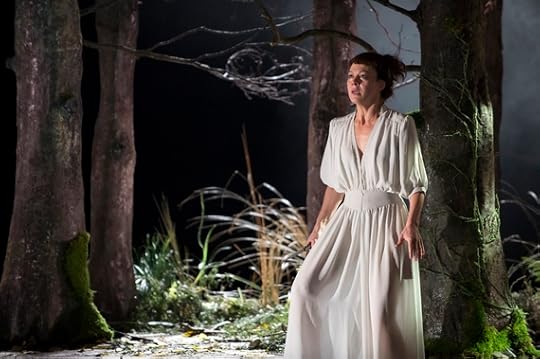
I don't think I've ever been so traumatised by a theatrical production ever. Not that Medea is a happy tale, of course. The story of a jilted wife, who murders her children as a way of revenge against her soon-to-be ex-husband is always going to be dark but Carrie Cracknell, in this new version of Euripides' work by Ben Power, brings us a genuinely disturbing production.
If you're unfamiliar with Medea, nothing I've told you is much of a spoiler. At the start of the play, the Nurse, a member of Medea's dwindling household, explains to the audience all that is to follow. What's left for us to consider is simply, is this a logical chain of events?
That's a hell of a gauntlet to lay down for any actor - to portray a chain of events, of thought, that could convince us that Medea's murderous acts are not just inevitable but understandable.
Taking up that challenge in the lead role is Helen McCrory and her performance is, well, is extraordinary enough? The superlatives could go on forever.
Her performance traumatises, it cuts deep into your soul to the point where you actually feel sorry for her. You pity Medea, at times you even understand her logic. But then at the end, as this broken insane mother crumbles in front of you, you just feel gutted to the core.
She's supported with a superb performance from Danny Sapani as Jason. That's Jason of the Argonauts fame, and her soon-to-be ex-husband.
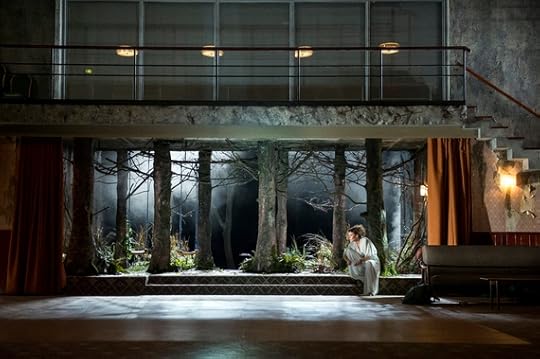
As he and Medea battle over his excuses and perverse logic of abandoning his wife for the sake of a political marriage that could save them all, the two seem to be more a middle-aged couple in crisis rather than a Greek tragedy version of Romeo and Juliet.
At first I was thrown by this. To validate a crime of passion, which is how I always figured Medea's crimes, I'd expected to see much more lust and love between this sparring couple. Yet actually this depiction of a couple where the first throes of passion are long gone robs Medea of that excuse and paves the way for what is a truly extraordinary study of an insanity that drives a mother to commit an act that seems unthinkable.
The very talented Carrie Cracknell directs but in spite of her many achievements to date (including A Doll's House at the Young Vic and Blurred Lines at the NT Shed) this production of Medea, for me, is her best.
The piece deteriorates into darkness at just the right pace, with brief moments of gallows humour breaking up just enough of the bleakness to keep us engaged without watering down the trauma.
And much is employed to echo this unravelling of Medea's mind.
The two-level stage design from Tom Scutt splits the interior of Medea's house from the streets of Creon, but more than this, it employs a dark forest as a metaphor for the dark places of Medea's mind.
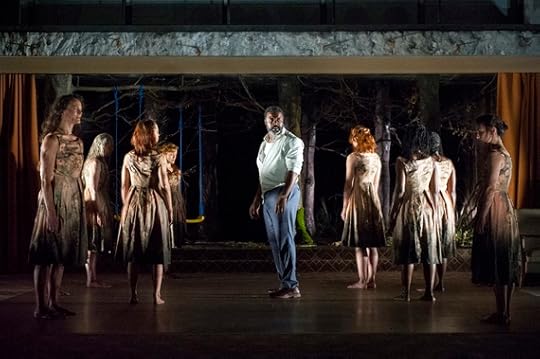
Carrie Cracknell also brought in choreographer Lucy Guerin to transform the women of Creon into an army of contemporary dancers, almost Stepford Wives-esque in their uniform of perfectly pressed A-line dresses with floral pattern.
But as these women move in choreographed steps, and speak in monotone almost mechanical voices, they seem to morph into outward projections of the voices in Medea's head, her unravelling mind laid out for us all to see.
The incorporation of this frantic contemporary dance to support and interpret the haunting score from Goldfrapp brought so much to the production. Its atmospheric impact is profound.
As the women jerk and convulse with the flashes of rage in Medea's mind, then dance distraught and wretched with the murder of Jason's new wife, I was genuinely quite shaken.
That's not to say that everything in this production is perfect. The quality of the supporting cast is not at the same level as Helen McCrory and Danny Sapani but given that they are only brief characters in the play, it isn't enough to dilute the pain in the piece.
At the end, as Medea staggers back onto stage under the weight of her crimes, I felt shattered, quite distraught. Such was the conviction and brilliance in Helen McCrory's acting that for Medea, this really did feel like the only possible, though god-awful end for her.
And for us to get to that conclusion is reflective of a quite brilliant production.
National Theatre, London to September 4, 2014
Image credits:
1. Helen McCrory as Medea, image by Richard Hubert Smith
2. Helen McCrory as Medea, image Richard Hubert Smith
3. A scene from Medea, Danny Sapani (centre) as Jason. Image by Richard Hubert Smith
Published on July 23, 2014 14:12



